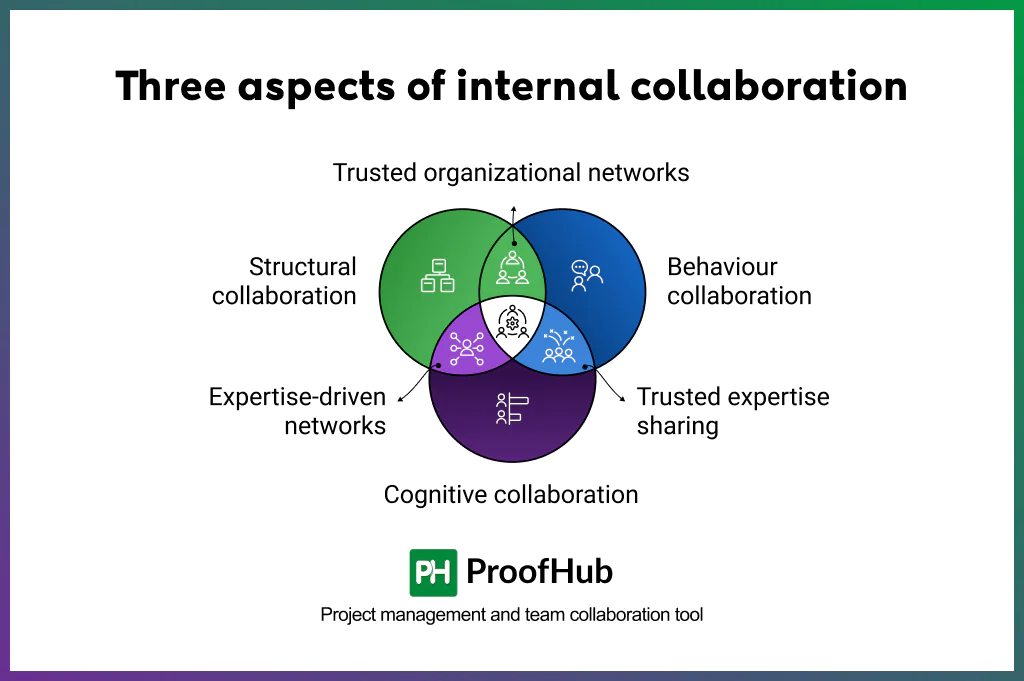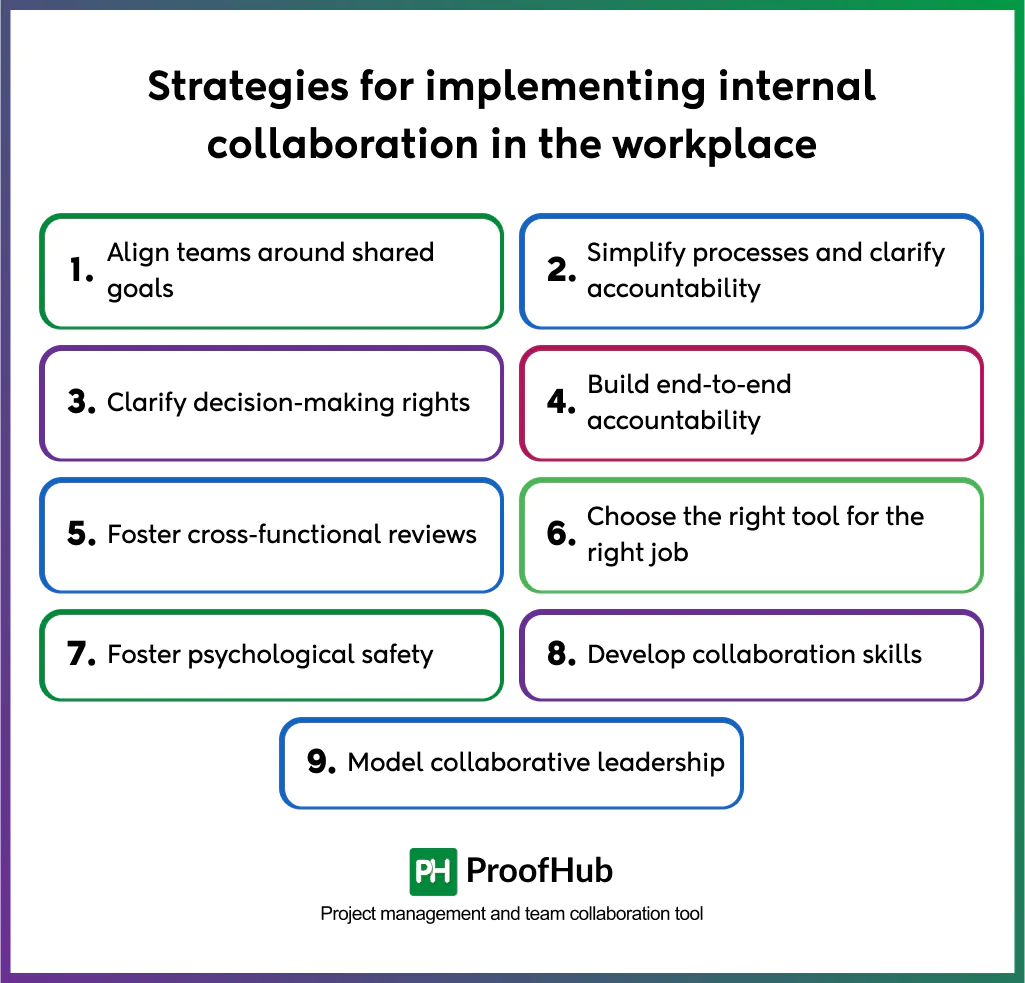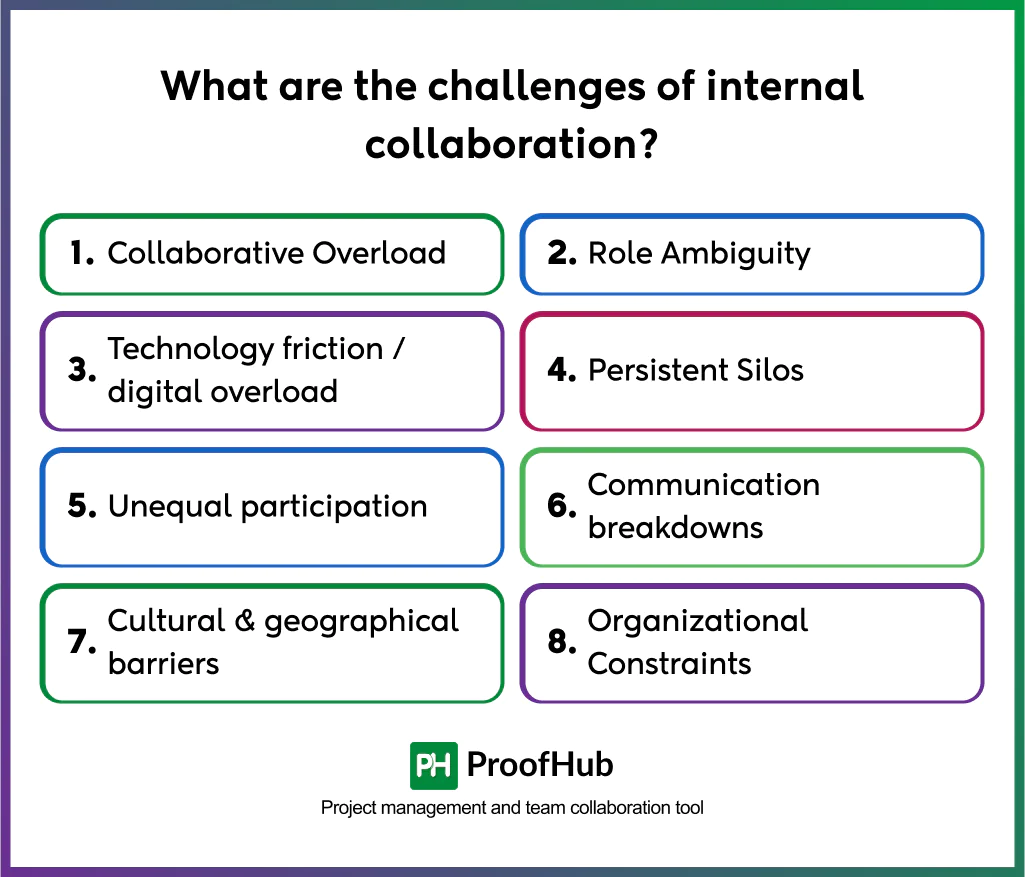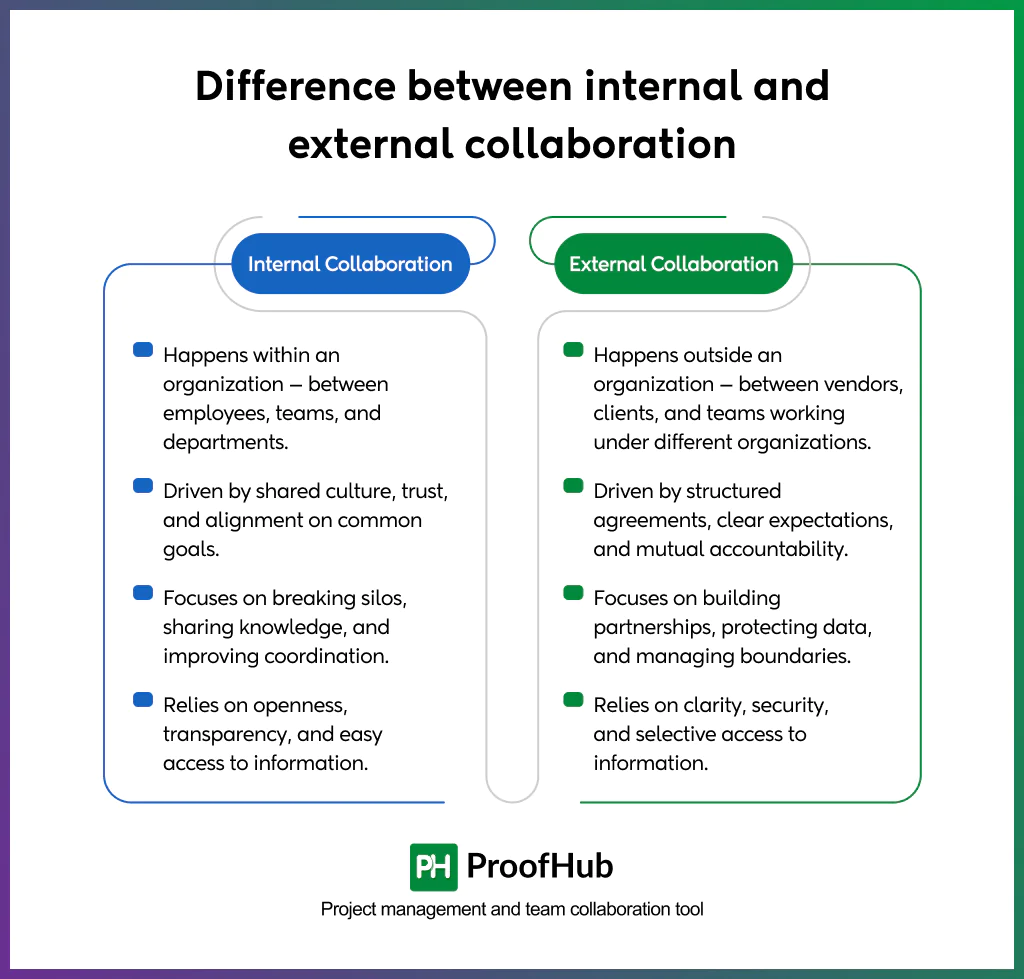
Internal collaboration is the process by which individuals within an organization work together to achieve shared objectives. It involves sharing information, agreeing on how things are done, and taking responsibility for outcomes across functions, rather than within a single department.
Effective internal collaboration enhances team performance, making it better, more productive, and more efficient. When teams coordinate, problems surface earlier, and employees spend less time repeating work or chasing missing details. Organizations see higher productivity, fewer mistakes, quicker time to market, and improved client satisfaction. Teams also gain more time for improvement and innovation instead of spending energy on fixing avoidable issues.
This article explains what internal collaboration is and why it matters for organizations. It outlines the benefits that strong collaboration brings to performance and growth. You will also find strategies for putting collaboration into practice and learn about the different types that exist inside companies.
What is internal collaboration?
Internal collaboration is the coordinated effort of employees across departments, roles, and levels within an organization to achieve shared objectives by aligning information, resources, and decision-making.
Internal collaboration is different from teamwork or communication alone. Teamwork refers to a single group working together on a task, whereas communication is the exchange of information.
Collaboration, by contrast, is the system that makes sure knowledge, skills, and perspectives flow across teams and hierarchies—so the whole organization can perform as one.

Internal collaboration unfolds across three interconnected layers:
- Structural: How departments, functions, and hierarchies are linked. Strong internal networks prevent silos and accelerate the flow of information.
- Behavioral: The trust, empathy, and psychological safety that encourage people to share openly without fear of judgment.
- Cognitive: Shared knowledge of “who knows what” in the organization, known in psychology as transactive memory systems. This helps teams tap into the right expertise quickly.
Together, these layers form a collective performance that brings specialized work.
Now that we know what internal collaboration is, let’s understand why leaders should invest energy in improving it.
What are the benefits of internal collaboration to an organization?

The benefits of internal collaboration are wide-ranging and bring real value to both the organization and the business. It helps people work better together, share knowledge more easily, make quicker decisions, and feel more involved in their work.
Good collaboration also breaks down silos, makes teams more flexible when things change, and ensures that skills, time, and information are put to good use. Here are some of the key benefits of internal collaboration:
1. Improved productivity
Internal collaboration improves productivity by eliminating silos, improving collective understanding, and reducing the duplication of efforts. When teams share knowledge openly, work flows faster and with fewer errors. Research from i4cp shows that companies promoting collaborative working were 5.5 times more likely to be high-performing. Instead of chasing updates or redoing tasks, employees spend their time creating value. For leaders, this translates directly into shorter cycle times and higher ROI on projects.
2. Innovation and problem-solving
Internal collaboration leads to breakthrough ideas that rarely come from isolated teams. They emerge when diverse perspectives come together. Research from Harvard Business Review shows that cross-functional collaboration significantly increases the odds of producing successful new products.
3. Employee engagement
Employees who feel connected to colleagues and understand how their work fits into larger goals are more engaged. Gallup reports that highly engaged employees show 78% less absenteeism and 14% higher productivity (based on evaluations and production records).
Engaged workers are more likely to stay with their employers. Internal collaboration builds a sense of belonging, reducing turnover and reinforcing commitment to organizational success.
4. Knowledge sharing and learning
Knowledge sharing and learning are improved by creating structured yet open channels for information exchange among team members. When teams collaborate across departments or roles, knowledge becomes a shared asset rather than an individual possession. Toyota’s production model, with its emphasis on shared problem-solving, is a practical example where collaboration turns individual expertise into collective intelligence and results in organizational growth.
5. Stronger organizational culture
Internal collaboration creates a stronger organizational culture by building trust, alignment, and shared purpose among employees. When individuals work together toward common goals, they develop a sense of belonging and mutual respect that strengthens the company’s social fabric.
Strategies for implementing internal collaboration in the workplace
To strategically implement effective internal collaboration, teams need to focus on three main aspects: people, processes, and technology. People set the norms and do the work; processes make the handoffs predictable and accountable; technology makes the processes visible and repeatable.
When accountabilities are set, goals are aligned, decision hierarchies are defined, and tools are integrated to support workflow, organizations operate as a single, coordinated entity rather than a set of competing silos. This alignment results in fewer contradictory commitments, faster delivery, and measurable reductions in rework and support costs.

The following is the list of key strategies that you can implement for effective internal team collaboration:
1. Align teams around shared goals
Aligning teams around shared goals means moving beyond siloed objectives and creating targets that require collaboration across functions. When goals are cross-functional, teams see how their efforts contribute to shared outcomes instead of only local priorities.
How to do it:
- Use frameworks like OKRs or SMART goals to make goals specific, measurable, and time-bound.
- Communicate goals broadly so all teams understand not just their role, but how their work ties into shared outcomes.
- Review progress jointly in cross-functional forums, celebrating wins and addressing obstacles together.
Shared goals create collective accountability. Teams begin to optimize for the success of the entire organization, leading to more cohesive execution, reduced internal friction, and a significant increase in overall efficiency.
2. Simplify processes and clarify accountability
Simplifying and clarifying processes means reducing unnecessary variation in how work gets done while ensuring ownership is clear. Standardization removes confusion, and accountability makes sure someone is responsible for delivering results across the whole process.
How to do it:
- Identify critical value chains and simplify steps where variation adds no value.
- Create shared templates, tools, and language so teams work consistently.
- Assign decision rights using RACI or RAPID and appoint process owners to maintain clarity.
Simpler processes and clear accountability eliminate wasted effort, reduce duplication, and ensure decisions move quickly.
3. Clarify decision-making rights
Clarify who has the authority to make which decisions, who must be consulted, and who is responsible for execution. Frameworks like RACI (Responsible, Accountable, Consulted, Informed) or RAPID (Recommend, Agree, Perform, Input, Decide) help remove ambiguity by mapping decision roles to specific individuals or teams.
Without clear decision rights, collaboration often breaks down into bottlenecks and turf wars. Teams either duplicate work, wait endlessly for approvals, or second-guess each other’s choices. This slows execution and frustrates employees. By clarifying decision rights, organizations reduce overlap and misalignment, making cross-functional collaboration faster and smoother.
How to do it:
Map critical decisions in each value chain or process that requires cross-functional input (e.g., product launches, handling client queries).
- Communicate decision authority broadly so teams don’t waste time negotiating ownership on the fly.
- Revisit regularly as roles evolve, since unclear or outdated decision rights often creep back in during reorganizations.
- Balance speed with inclusion — involve enough stakeholders to ensure buy-in, but avoid bloated decision-making that stalls progress.
With decision rights clarified, cross-functional teams can act with confidence and speed. They no longer get bogged down in debates about “who owns this” and instead focus on execution.
4. Build end-to-end accountability
End-to-end accountability means assigning clear ownership of an entire process or outcome. It forces alignment across teams and departments, ensuring that internal collaboration produces results that are coherent, efficient, and effective for the whole of the organization.
How to do it:
- Set shared metrics like on-time delivery, project completion rates, or employee experience scores that encourage teams to succeed together.
- Reinforce with cross-functional reviews where teams analyze performance jointly and agree on improvements.
- Elevate accountability by assigning strong managers or senior leaders to coordinate complex, high-impact processes end to end.
When accountability is set, everyone knows who is responsible for the outcome, which reduces confusion and builds trust across the workplace.
5. Foster cross-functional reviews and feedback loops
Cross-functional reviews are structured forums where representatives from different teams track progress, resolve bottlenecks, and share insights. Unlike siloed meetings, these reviews focus on outcomes across the entire process and build joint ownership.
How to do it
- Schedule regular reviews around shared outcomes, like onboarding time or delivery accuracy.
- Use KPIs that reflect end-to-end performance, not just functional success.
- Encourage open discussion of root causes and co-create action items.
Cross-functional reviews make collaboration practical. They enable faster resolution of issues and create customer experiences that feel seamless across teams.
6. Choose the right tool for the right job
By choosing the right tool for the right job, teams spend less time chasing information and more time creating value. Workflows are smooth, and colleagues get faster, more reliable responses because internal communication isn’t lost in the shuffle.
If teams rely on chat for project tracking, important details get buried. If email is the default for urgent issues, response times suffer. Over-reliance on the wrong tool creates confusion, duplication, and fatigue.
How to do it:
- Map collaboration needs (e.g., brainstorming, daily coordination, long-term planning, knowledge sharing).
- Assign clear “homes” for each type of work — chat for quick decisions, project software for execution, wikis for knowledge.
- Establish rules of engagement (e.g., project updates live in the tool, not in email; decisions are documented centrally).
7. Foster psychological safety
Fostering a culture of psychological safety creates an environment where people feel free to share ideas, and leaders model openness. When psychological safety is absent, employees stay silent. These silences lead to rework, delays, and frustrated co-workers. A culture of safety and collaborative leadership strengthens trust, speeds up problem-solving, and encourages innovation.
How to do it:
- Build psychological safety by rewarding achievements and surfacing mistakes early.
- Provide training in listening, feedback, and conflict resolution.
- Have leaders share decision rationales, invite dissent, and recognize cross-functional contributions.
8. Develop collaboration skills
Collaboration skills include active listening, giving and receiving feedback, resolving conflicts constructively, and facilitating group problem-solving. Without these shared skills, teamwork often defaults to uneven participation, unresolved disagreements, or decisions dominated by the loudest voices.
How to do it:
- Offer training in listening, constructive feedback, and conflict resolution, not just technical skills.
- Use role-play scenarios (e.g., resolving cross-departmental disagreements) to practice in safe settings.
- Encourage peer coaching where employees observe and give feedback on collaborative behaviors.
- Build collaboration expectations into performance reviews to consistently reinforce skills.
9. Model collaborative leadership
When leaders model transparency and openness, teams mirror these behaviors. Insights are shared, risks are flagged early, and cross-functional coordination improves — creating a smoother, more consistent experience for everyone engaged.
How to do it:
- Share decision rationales, not just decisions, so people understand the “why.”
- Invite dissent in meetings and actively acknowledge contributions from quieter voices.
- Demonstrate cross-functional curiosity by asking leaders from other departments how your team’s work impacts theirs.
- Publicly recognize examples of collaboration, making it visible that these behaviors matter.
What are the challenges of internal collaboration?

Internal collaboration seems simple: get people to work together, and results should follow. In reality, it’s one of the hardest things for organizations to execute well. Challenges aren’t just about tools—they’re structural, cultural, and human.
1. Collaborative Overload: Too much collaboration can hinder productivity. A Harvard Institute researcher, in collaboration with Prof. Bob Ross, found that employees may spend up to 75–85% of their week in meetings, email chains, or chat threads, leaving little time for focused work. When every task requires group input, collaboration becomes a bottleneck rather than an enabler.
2. Role Ambiguity: When responsibilities are unclear, motivation suffers. Employees hesitate to act, duplicate work, or dispute ownership. Clear role definitions within the collaborative workflow are essential to prevent confusion and maintain accountability. When collaboration blurs who is responsible for what, motivation suffers.
3. Technology friction / digital overload: Using multiple collaboration tools like Slack or Teams improves efficiency, but can create friction. Multiple platforms, poor adoption, or inconsistent training make it harder for employees to know where to look, slowing work and reducing alignment.
A Deloitte survey in 2022 found that 75% of employees reported increased digital overload while working from home, with many linking it to higher burnout.
4. Persistent Silos: Departments often protect local priorities, limiting cross-team knowledge sharing. Even with collaboration tools, teams may focus on individual goals instead of organizational objectives, leading to misalignment and fragmented execution.
The result is duplication, misalignment, and a lack of shared accountability. Research from Harvard Business Review Analytics Services found that 67% of collaboration failures stem from silos—a staggering figure that shows how destructive fragmentation can be.
5. Unequal participation: Some voices dominate while others remain quiet. This uneven participation undermines collective intelligence, resulting in weaker decisions and missed perspectives. Creating inclusive processes is essential to harnessing diverse insights.
6. Communication breakdowns: Information can get lost across platforms, buried under noise, or delivered too late. Poorly managed collaboration can make finding the correct information harder, decreasing efficiency and clarity.
7. Cultural & geographical barriers: Global, remote, or hybrid teams face challenges from differences in culture, communication style, and time zones. What is proactive in one culture may feel intrusive in another, and scheduling across regions can unintentionally exclude participants.
8. Organizational Constraints: Collaboration is shaped by structural realities: rigid hierarchies, slow decision-making, and resource bottlenecks. Without designing processes that fit these constraints, leaders risk overpromising outcomes and creating frustration.
What are the best tools for internal collaboration?
The best tools for internal collaboration are the ones that actually help teams work together without compromising their existing workflows. A good tool should centralize conversations, make tasks and responsibilities visible, and reduce the need to juggle multiple apps.
Here are some of the best software for team collaboration:
- ProofHub is the best choice if you want an all-in-one platform. Instead of scattering communication in Slack, planning in to-do lists, and files in Drive, ProofHub pulls everything into one workspace. That means fewer logins, less context-switching, and a single source of truth for projects, tasks, discussions, and reporting. Plus, its flat pricing model with no per-user fee provides you the flexibility to add as many users as you like.
- Slack is suitable for quick conversations and creating dedicated spaces (channels) for teams or projects. By itself, Slack is a good communication tool for internal communication. However, it lacks other aspects of collaboration, such as planning and tracking,
- Microsoft Teams is a widely used software by organisations that are already invested in Office 365. It combines chat and video calls with deep integration into Word, Excel, and Outlook.
- Notion is great when documentation is at the centre of collaboration. It works well as a shared knowledge base, though it’s less effective for structured project execution.
- Miro shines when teams need to brainstorm visually — think workshops, whiteboarding, or mapping out processes. It’s a complement rather than a core system of record.
If your team is small and only needs a single-purpose tool, options like Slack or Notion can work well. But to reduce tool overload, improve visibility, and keep everything aligned in one place, ProofHub stands out as the best long-term solution.
What are the examples of successful internal collaboration?
Successful internal collaboration isn’t about teams using the same tool — it’s about how they structure work, share knowledge, and stay aligned as they move toward a goal. When you look at real-world examples, a few patterns stand out:
1. GitHub’s engineering teams
Developers at GitHub use pull requests, code reviews, and shared repositories to work together. These practices make workflows transparent — everyone can see what’s happening and contribute to improving it, resulting in better quality and stronger alignment.
2. NASA project teams
NASA coordinates massive, complex missions by using highly structured workflows and centralized knowledge sharing. Engineers, scientists, and project managers align through detailed dashboards, milestone tracking, and strict accountability. This proves that when stakes are high, shared systems and clear responsibilities make collaboration not just helpful, but mission-critical.
3. Airbnb product teams
Airbnb organizes product development around cross-functional squads that run structured sprints. Designers, engineers, and product managers plan together, share feedback continuously, and rally around clear goals. The key takeaway: collaboration improves when roles are clear, goals are shared, and feedback loops are short.
The patterns across all these examples are common. Collaboration succeeds when teams combine three things: clarity (processes and roles), transparency (visibility into work), and centralization (a shared system of record).
What are the further types of Internal Collaboration?
Internal collaboration occurs across team members through various formal and informal means. Here is the list of the most common types of internal collaboration observed in successful organizations:
1. Cross-functional collaboration: Cross-functional collaboration connects people from different teams or departments to work toward a shared outcome. It goes beyond the boundaries of one division, pulling in diverse expertise from different departments.
2. Manager-team collaboration: Manager-to-team collaboration is the two-way interaction between leaders and their direct reports. It includes setting goals, clarifying expectations, sharing feedback, and creating space for open dialogue. Unlike top-down directives, this form of collaboration is about alignment and trust between managers and their teams.
3. Peer-to-peer collaboration: Peer-to-peer collaboration happens when colleagues at the same level work together, often across different teams or domains. It cuts through organizational silos, reduces dependency on managerial mediation, and builds a culture of mutual support. When employees collaborate laterally, they often spot issues faster, share knowledge more freely, and create stronger networks across the company.
4. Knowledge-sharing collaboration: Knowledge-sharing collaboration is the deliberate exchange and documentation of expertise, insights, and experiences within an organization. Without structured knowledge sharing, organizations risk repeating mistakes, duplicating effort, and losing critical know-how when employees move on.
5. Leadership collaboration: Leadership collaboration occurs among executives or department heads who coordinate on strategy, priorities, and resource allocation. It focuses on aligning organizational goals and making high-level decisions that affect multiple teams or functions.
What is the difference between internal and external collaboration?

The key difference between internal and external collaboration is the participants involved. Internal collaboration focuses on teams working together within an organization, while external collaboration consists of coordinating with clients, partners, or vendors outside the organization.
Internal collaboration is about creating alignment among employees so everyone is moving in the same direction. It works to break down silos, making sure information and resources flow freely across teams. Strong internal collaboration builds a culture of openness and trust — where people feel comfortable sharing ideas, asking for help, and contributing to collective problem-solving. The result is smoother workflows, faster decision-making, and a stronger sense of ownership across the organization.
External collaboration is about managing relationships beyond the company’s boundaries. Here, the focus shifts to setting clear terms of engagement — defining deliverables, timelines, and responsibilities in a way that avoids confusion. Successful external collaboration ensures that clients, vendors, or contractors can contribute meaningfully to projects. When done well, it builds trust, strengthens partnerships, and creates long-term value.
| Internal Collaboration | External Collaboration |
| Happens within an organization — between employees, teams, and departments. | Happens outside an organization — between vendors, clients, and teams working under different organizations. |
| Driven by shared culture, trust, and alignment on common goals. | Driven by structured agreements, clear expectations, and mutual accountability. |
| Focuses on breaking silos, sharing knowledge, and improving coordination. | Focuses on building partnerships, protecting data, and managing boundaries. |
| Relies on openness, transparency, and easy access to information. | Relies on clarity, security, and selective access to information. |
Can remote work affect internal collaboration?
Yes, remote work has a significant impact on internal collaboration. Its effects can be both positive and negative, depending on how well teams adapt their tools, processes, and culture.
Remote work can make communication feel fragmented if conversations aren’t structured. Without clear systems, updates get lost across chat threads and emails, leaving teams unsure of priorities. Visibility can also suffer — when progress isn’t transparent, managers may feel disconnected and employees may feel unseen. Team cohesion is another risk, since remote settings naturally reduce informal interactions and the sense of belonging that comes from working side by side.
On the positive side, remote work also enables greater flexibility and focus. Teams are no longer bound by physical presence, which means collaboration can happen asynchronously — people contribute when they are at their best, rather than being forced into constant real-time communication. This allows for deeper, uninterrupted work while still keeping projects moving.
Can internal collaboration impact project efficiency?
Yes, internal collaboration directly affects project efficiency by improving coordination, reducing redundancies, and enabling faster decision-making.
Effective internal collaboration makes work move smoothly, keeps projects on track, teams share information openly, tasks are clearly owned, and decisions get made faster because the right people are aligned from the start. This prevents the project slowdowns, like waiting for approvals, redoing work that was misunderstood, or struggling to find missing information. In well-collaborating teams, efficiency is built into the system itself.
When internal collaboration is not done effectively, it leads to inefficiencies, misunderstandings, delayed updates, and people lose sight of priorities. Work slows not because the project is complex, but because communication is fragmented. The result is duplicated effort, mounting frustration, and wasted time that could have been avoided.
Does organizational culture influence the effectiveness of internal collaboration?
Yes, organizational culture plays a critical role in shaping how well teams collaborate, influencing trust, accountability, and knowledge sharing.
A strong collaborative culture encourages psychological safety, where employees feel comfortable sharing ideas, raising concerns, and asking questions without fear of judgment. This openness accelerates problem-solving and fosters innovation because people feel secure to share the ideas.
When teams are transparent, track progress, and understand decisions, trust builds naturally. A culture where diverse voices are heard and different perspectives are welcomed, internal collaboration thrives.
When teams know that their contributions are recognized and aligned with organizational priorities, collaboration becomes a habit rather than a chore.
To sum up, teams with the right culture, supported by effective processes and collaborative tools like ProofHub, communicate better, make faster decisions, and achieve goals more efficiently. Without culture, even the most advanced collaboration platforms can’t deliver their full potential.






